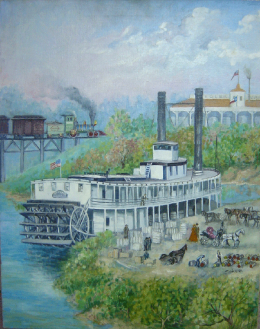
As the Rail Meets the Sea
© Judith-Ann Saks -1975 All Rights Reserved
oil on canvas
Larger Image
| 10" x 13" Giclée | $89 | ||
| 12" x 16" Giclée | $175 | ||
| 15" x 20" Giclée | $299 |
As the Rail Meets the Sea
This is the scene at Allen's Landing around the year 1870 as our nation approached its Centennial. The St. Clair is typical of the large stern-paddle steamers which traveled rivers like the Mississippi and along the coast carrying passengers and cargo. There are passengers who have disembarked, one of whom is leaving in a carriage. Cotton, then king of crops, is being loaded after being brought from inland on mule-drawn wagons which stand near-by. The barrels contain resin or molasses.
Now, Allen's Landing has been cleared of trees and brush except that near the water's edge.
The brightly-colored locomotive on the trestle over White Oak Bayou at its junction with Buffalo Bayou is the "General Sherman", the first engine used in Texas. Through Joe Bart of the Southern Pacific Railroad, the artist found George F. Wessels, a retired railroad executive, who was given a scale model of the General Sherman on his retirement. Locomotives and other equipment of that era were all brightly colored. Back of the coal tender is a Wells Fargo box car, authentic for the times, as is the clothing in the painting which was researched from newspaper ads of the period and other sources.
As the rail connected with the waterway, Houston rapidly became a busy city. Ziegler's warehouse, one of the first warehouses to store goods for import or export, is painted with a United States and a Texas flag that is symbolic that Texas is now part of the United States.
Thus, in less than forty years after the Laura struggled up the overgrown Buffalo Bayou to a tent village on the prairie, Houston had become a thriving shipping and trading center. At the height of rail activity, there were seventeen rail lines meeting the sea serving Houston and its port.
